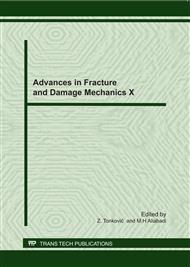p.755
p.759
p.763
p.767
p.771
p.775
p.779
p.783
p.787
Failure Analysis of Bolted Composite Joint Based on Extended Finite Element
Abstract:
In this paper, the influence of geometrical parameters on failure load of bolted single-lap composite joint was investigated. The composite laminate was manufactured from HTA/6376, a high-strength carbon fiber–epoxy material currently used in primary structures in the European aircraft industry. Two geometrical parameters which were plate width-to-hole diameter ratio (W/D), and the edge-to-hole diameter ratio (E/D) were analyzed. To avoid modeling each ply of the laminates discretely, the laminates were modeled using equivalent linear elastic properties. the failure analysis was modeled by Extend Finite Element Method (XFEM) in ABAQUS. Maximum principal stress criterion (Maxps) was used to determine the failure load.
Info:
Periodical:
Pages:
771-774
Citation:
Online since:
September 2011
Authors:
Price:
Сopyright:
© 2012 Trans Tech Publications Ltd. All Rights Reserved
Share:
Citation:


